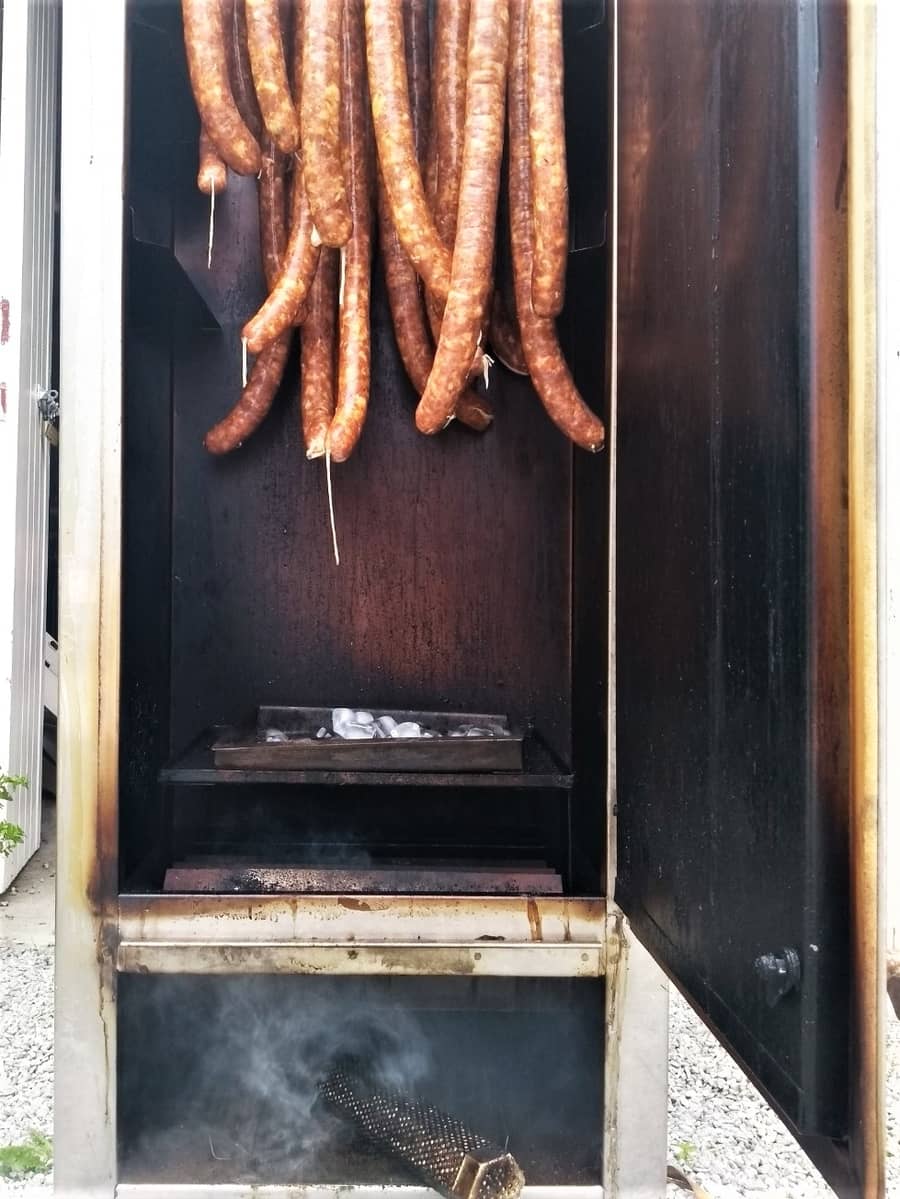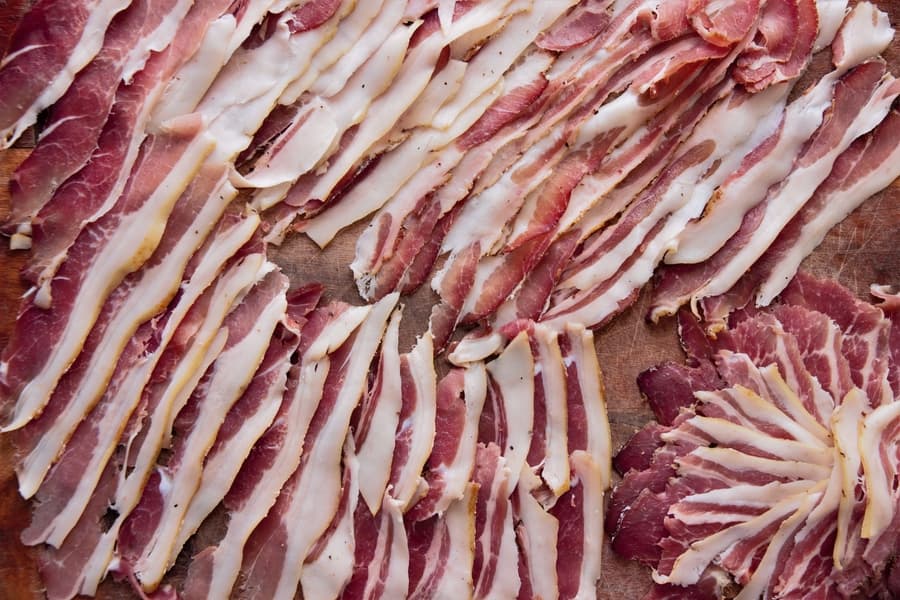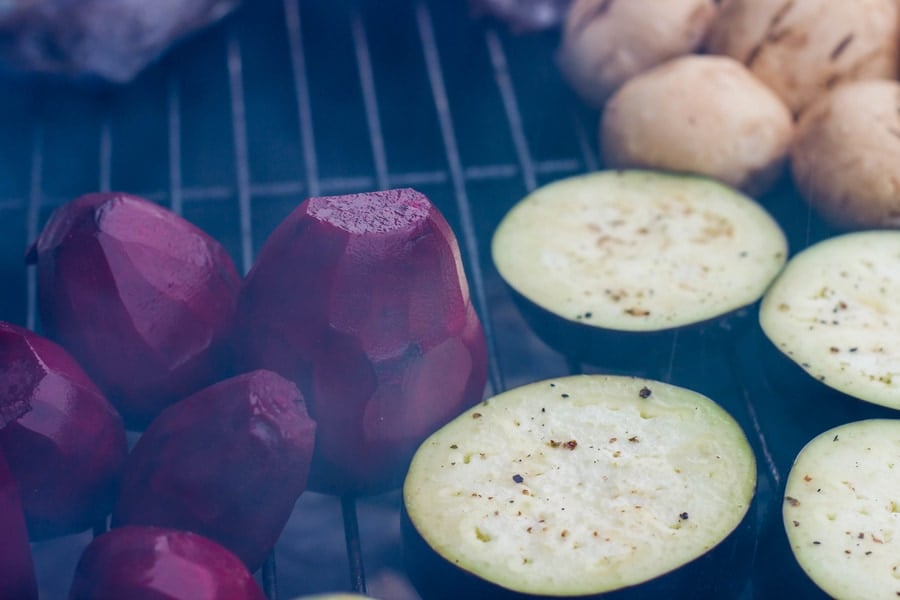Cold smoking food is a passion; the preserving effects on food I have experienced firsthand for quite a few different foods. It’s been amazing cold smoking various meats and also different types of dairy & vegetables.
When the meat is cold smoked, it becomes preserved and will last months longer without freezing. Cold Smoking is a form of drying the meat to a point where the bacteria does not have enough moisture to thrive. Cold Smoked non-meat foods are not preserved; this is for flavor enhancement.
When you cold smoke in higher humidity at a lower temperature, you are, in fact, ‘drying’ the food; I guess you can look at this as slow ‘dehydrating’ the food—but using the properties inside the smoke vapor to protect the meat.
It’s one of those questions that so many people ask when I tell them about cured meat, “Is it cold-smoked?”.
Preserving Role of Cold Smoking Food
Cold smoking is one of the oldest forms of preserving food and helped civilization prosper when they didn’t have fridges, some literature I have read mention, the preservation of meat was quite the technological leap for our planet.
When I first started learning cold smoking from a Dutch butcher, it was an incredibly simple system (which most cold-smoking setups are). A massive metal double door ‘smokehouse’, with a pile of sawdust on the ground, slowly smoldering. I thought, is that it? But I will review key factors I have studied over the years below.
The smoke also helps prevent the meat from going rancid; certain compounds in the smoke help the preserving effect.
Of course, when it comes to cold-smoked foods, there are many options. By living and traveling across Europe, you can see many parts of a very strong cold-smoked food culture.
I have found that you can have a super simple setup—for example, a metal tube smoldering inside the hood of my gas grill BBQ.
What is Cold Smoking?

- Using salt to remove moisture so that it’s a hostile environment for unwanted bacteria that can spoil the meat
- ‘Dry’ the meat by exposing it to smoke in a ventilated smoking area that is under 86°F/30 °C (I prefer most meats around 50-68°F/10-20°C.
- Through the reduction of moisture and preservation (here are some economical preserving methods I wrote about) properties of the smoke, your meat reaches a point where the types of bacteria that spoil the meat are minimized.
- Temperature & humidity are both factors that need to be figured out to have cold smoked meat.
- Non-meat – easier since it’s about putting smoke flavor (you can not even use a smoker to get smokiness; I wrote about this here) into the food. Most recipes I have read and tried say less than 1 hour when you are smoking vegetables or dairy.
During the process, the temperature needs to be cool, between 50-86°F/10-30°C. So I generally will choose cooler nights to let the meat smoke for 4-7 hours before it goes out. It just ends up drying out a little during the night.
A giant light bulb moment was when I read a book called ‘Cured’ by Lindy Wildsmith. She checked out some commercial smokehouses, and the concept of humidity is essential.
The smoke carries specific properties that help preserve and prevent the meat from spoiling.
It’s similar to the concepts of dry curing meat, i.e. prosciutto & pancetta. I have been practicing for decades, the goal is to lose moisture weight through drying at least to 35%. It can be done in open-air, but generally, those who practice this as a hobby have built a DIY Curing Chamber to control the temperature & humidity during the process.
I have had some success doing this in a regular fridge, just using smaller cuts of meat, if you’re interested I wrote a post here about it.
Different Cold Smoked Foods

Different meats react differently to cold smoke once they have been cold smoked. You put them in the fridge, and they should last months, ideally without air/oxygen around them. It is also how much meat is exposed or cut into.
But once you have opened the package, it can have a shorter shelf life for stuff like precut smoked salmon. You could hang it up in winter if it was a cold smoked salmon. More than likely, it would last for months!
Cold Smoked Fish
When I first heard that a caught fish lost weight as soon as it was out of the water, it was an interesting observation. Since curing for cold smoked meat is about removing moisture spoilage bacteria can’t grow. I think the moisture need that needs to be removed before it is preserved by drying through cold smoking (more I wrote on smoking and how it preserves here) can vary.
From what I have read about commercial production, common cold smoked fish like salmon has a 20-25% weight loss when it is considered ‘preserved.’ But there is a difference between how dry it is – I would say just read the package.
If you are making your own, that is a whole different story.
Cold Smoked Red Meat
I harvest red meat and experiment with it. The quality of the meat may also have some factors toward preservation. In the book, Cured – Charles mentions that meat that hasn’t been altered or ‘commericalized’ may carry more beneficial bacteria for preservation, hence 1,000 years ago there wasn’t such a need for nitrates to assist in minimizing the bacteria that could spoil the food.
Cold Smoked Vegetables
This is purely for flavor, my favorites are eggplant and beetroot – but I have found you have to use lighter flavored woods, like fruit woods, and salt the eggplant to draw some of the moisture out, then into the kettle grill, with a cold smoke generator attached – easy.

Check out this post if you want a quick guide on different woods and how I have chosen and used them.
Cold Smoked Dairy
We had some exciting experiments with chocolate & cream – with some unique flavor angles. A recipe for smoked cream potato Gratin came out fantastic in the book. The cream was just cold smoked in a bowl for 1 hour using apple wood at about 59°F/15°C.
Cold Smoked Dry Cured Salami
Like Hungarian style salami for instance, I made recently got about 3-4 days/sessions of cold smoking from around 15-25°C, they came out amazing! I used a translated recipe that was strongly flavored with quality Hungarian Paprika (sweet compared to most; we bought it in Hungary, of course!) and garlic.
Cold Smoking at Home – Options
If you want to get into cold smoking at home, you need a little bit of space outdoors and suitable environmental conditions (winter is best in many places)
- Mid to Higher humidity (not so crucial for non-meat products)
- Temperature – 50-68°F/10-20°C
You can turn a cheap sieve inside out, and just light one end of a circular pile of chips or wood pellets (haven’t tried it but hear it works).
Pellet Tube smokers are a super simple portable way of cold smoking to add a whole new dimension to your favorite cheeses (I highly recommend cheese for beginners). This can be placed inside a reasonable-sized BBQ and provides cold-smoked capabilities! I tried it inside my small kettle grill, but it was producing a little too much heat, so I used the five-burner gas grill with a hood instead.
One big tip is once you have cold smoked whatever you wanted, putting it covered or in a container overnight in the fridge will always intensify the flavor.
And another big tip is less smoke is way better than too much smoke. So, go easy to start with and do a short session with dairy or cheese, say 30 minutes, then try it the next day and see what you think.
Curing meat is a craft and an art; it doesn’t entirely fall into the same category since you have a more diverse set of parameters that will influence the outcome.
I started with a smoke generator (review of one of my favorites), which meant I could pump smoke into any area/chamber I wanted. It’s fantastic since, the air pump is variable so that I can choose the level of smoker.
If you can get the right temp conditions, ie. under 86°F/30°C with relatively high humidity, then you can use super simple equipment to cold smoke.
For vegetables, cheeses, or even chocolate, it takes no prep, and you just let the smoke do the work. Humidity isn’t as important either for an hour of cold smoking.
For meat, it’s always essential to set it up properly since cold smoked meats usually take days generally (1-14 days or like 1 to 14 smoke sessions, including drying in cool areas when not smoking).
Here is a quick, short breakdown of the process I have learned.
How to Cold Smoke Meat
- Fully cure the meat using the saltbox, brining, or equilibrium curing method.
- Create or adhere to the right temperature/humidity conditions (humidity is more critical for meat)
- Create smoke and let the meat smoke
- Dry in between smoking sessions
- Meat is cold smoked once desired weight loss has been reached.
If you want to know more about cold smoking, check out a beginner’s post I wrote here.
Related Questions
How Does Cold Smoking Preserve Meat?
In a cool environment, with air and cold smoke or with salt-curing, air and cold smoke. The drying effect preserves the meat by removing the moisture, creating an environment where unwanted bacteria cannot thrive. The smoke has beneficial properties that aid in preservation. The meat is preserved once moisture levels are reduced to a certain degree.
What is the Best Temperature for Cold Smoking?
For meat or other foods, the best temperature for cold is between 10-30°C / 50-86°F. Above 30°C, meat begins to cook. Humidity is also a factor that needs attention during cold smoking of meat.

Tom Mueller
For decades, immersed in studying, working, learning, and teaching the craft of meat curing, sharing the passion and showcasing the world of charcuterie and smoked meat. Read More

Thank you for a nice article.
In what ideal conditions do you store the meat after it have been cold smoked?
I am especially interested in how this is done without electricity, as in the old days.
Well, I think back in the day the saltiness was WAY higher so the meat was heavily cured therefore tolerated higher temps. I would be guessing, but generally curing/cold smoking for preservation was of course autumn/winter. Depending on geography of course.
Personally I don’t like over 77-83°F/20-23°C
Also, my new trick is vacpac with reuseable bags, they have a manual valve. You use a basic pump and suck out all the air (vacpac but reuseable). Then I stick the bag in the curing chamber which is always around 55°F/12°C
Hey Tom, if I am going on a backpacking trip would it be feasible to bring smoked Slovenian sausage and pork as a quick and easy source of protein and fat? Temps on the trip can range from 40-85 Fahrenheit. The meat would be dry kn weatherproof bags. Thanks and thanks for all the knowledge!
Hey Eric, depends on how its smoked? Smoked hot ie. cooked with smoke or cold smoked/dried – cold smoked I would take on a trip. ‘dry cured’ means the moisture has been taken out so the bacteria find it hard to spoil it. Biltong or jerky would be other alternatives which are dried a lot and biltong uses vinegar to denature (cook) the meat as well 🙂 Happy hiking! Dry Cured Bacon is popular when I go hunting. Lastly, you aren’t carrying the ‘water’ weight as well!
Hi Tom. I’m really enjoying reading your articles – thanks so much for posting your knowledge. I do have a question which has been bothering me for a while about cold smoking bacon though. Once cured, is there a maximum temperature and period of time the bacon should be exposed to within the chamber? Obviously the overall HACCP guidelines dictate that certain foods such as raw, un-dried meat should be essentially kept below 4C/39.2F at all times, so it would be great to know how this becomes acceptable in a cold smoking environment. Many thanks!
I’ve never done anything commercial, just 20 years of at-home curing. The books I’ve read and the professionals I’ve talked to say under 15C works for them. Officially they say cold smoking is under about 30C (I believe fish starts to cook above this temp, I guess slowly….).
I prefer when cold smoking cream, milk or meat to be under about 15C. Humidity plays a part too with meat or dry cured cold smoked bacon! Cheers T
Thanks Tom. I used to do salmon quite comfortably around 22C and bacon too and it all seemed fine. I have the Mariansky books amongst many others and whilst there is guidance on the subject it is a bit scant, but as you suggest the lower the better really. I’m in the UK, so cold smoking at night and therefore below 15C is possible for a big chunk of the year. Thanks once again. J
nice one, I agree completely. Don’t agree with all things in the Marianski books, but most of it is on point! But they are definitely a fully credible resource. I’m the same in New Zealand, night-time or winter (10-15C daytime). Humidity with meat is key!
Hi Tom,
I cold smoked 2 pigs last winter. heavy salt cure first. I live in midcoast Maine and followed a youtube of an old guy in Kentucky who hangs his meat for years before eating. My hams have been hanging and we’ve eaten up the bacon mostly, now cutting into a ham.
Two questions:
1. We have larder beetles on some meet. The hams were glazed with cayenne and molasses and sugar rub. not stopping the beetles. Do you think rubbing a thick layer of lard or oil would help? Also cut out infected meat?
2. Preserving longer? I am hanging them in my smokehouse which in Maine goes from -5 to 100 F possibly. Kentucky would be about the same according to the old timer on youtube. I have a root cellar. Humidity is about 60-80% year round. this time of year it is 80. Is it a bad idea to store them in there? Maybe vacuum seal?
Thoughts?
Thanks, I love your articles.
PS. there is a local old timer who is 90 who recently pulled lardo out of a brine barrel that was 20 y.o. He replaced the brine every year but then forgot to do it for the previous 3 years. Found the barrel one day and said, “if I’ll be darned.” then had the lardo for lunch. Still good.
Hey Steve,
Thanks for the comment, wow lots going on!
I have never experuenced larder bettles, I dry meat in a DIY curing chamber – wrote a post on that here. For me equilibrium curing and using a controlled curing chamber fridge helps me achieve more consistent outcomes.
1. If I had bug problems, I would cold smoke more (smoke has antibacterial/antifungal properties too)
2. A big variation in temp is far from ideal, you need to keep it ideally well under 68°F/20°C – under 60°F, again this is why controlling the environment in a fridge works (I’ve also had 1000 Gallon commerical fridges converted before which could easily handle 2-3 pigs (I use wild venison alot).
If I were to vacpac, then I would keep at regular fridge temp, say 35°F/3°C – that’s how I store long term for dry cured or cold smoked goods (if you have mold on the outside ideally get rid of it before vacpac with vinegar.
Too many variables and I have no idea about yr complete setup, but if muscles are covered with skin, this can help protect the meat if keeping in a root cellar. The root cellar sounds better then the smoke house 🙂
Again, I can’t really comment alot when guys go down traditional methods, since there are many variations – I am now exclusively using equilibrium curing and controll the environment as mentioned.
All the best,
Tom